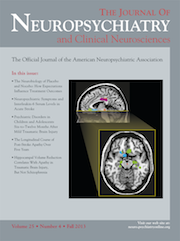Orobuccolingual Dyskinesia After Long-Term Use of Black Cohosh and Ginseng
To the Editor: Black cohosh (BC), also known as Cimicifuga racemosa, is a frequently used herbal remedy for alleviating menopausal symptoms.1 Ginseng has been widely used as herbal medicine in eastern Asia.2 We report a on a patient who developed orobuccolingual dyskinesia (OBLD) while being treated with an herbal supplement containing BC and ginseng.
Case Report
A 46-year-old woman was admitted to our hospital with a 3-month history of OBLD that interfered with her speech, tongue-biting, and eating difficulties. Her neurological examination was otherwise normal except for OBLD (Abnormal Involuntary Movement Scale Score [AIMSS]: 8). Her personal and family history were not relevant for neuropsychiatric disorders. The patient denied any exposure to dopamine-blocking drugs or other medications. She reported the use of a 2-tablet/day dose of a plant-based preparation containing 20 mg BC and 50 mg Panax ginseng to treat her menopausal symptoms for at least 15 months. The general physical examination, routine blood examinations, and comprehensive tests for movement disorders (also including genetic tests) were all normal. Her cranial computerized tomography, contrast-enhanced cranial magnetic resonance imaging, and cranial fluorodeoxyglucose positron emission tomography were also normal. The preparation was stopped. She improved substantially with a combination of baclofen 40 mg/day and clonazepame 2 mg/day (AIMSS: 2).
Comment
To our knowledge, this is the first reported case of OBLD observed after the combined use of BC and ginseng. The action mechanisms, pharmacokinetics, and metabolites of BC have not been totally identified. Recent data have demonstrated that BC may have an effect on dopaminergic, serotoninergic, and GABAergic systems.1 It has been suggested that unknown dopaminergic compounds may contribute to the pharmacological activity of BC.3 More than 30 different ginsenosides, the main components responsible for the actions of ginseng, have been isolated and identified from ginseng.2 In spite of some in-vivo studies indicating that some ginsenosides can be neuroprotective to striatal neurons,4 the results from a recently-published in-vitro study were mixed. This study has shown that low doses of some ginsenosides exhibited striatal neuroprotective effects, whereas overdoses have caused striatal toxic effects.2 Wu et al.2 reported that there could only be a fine line between the neuroprotective and toxic effects of ginsenosides. The use of ginseng can cause complications when used in combination with other medications. Adverse effects, including nervousness and insomnia,2 have been reported from long-term use and high doses of ginseng; BC has been linked to liver, cardiovascular, CNS, and peripheral nervous system adverse events. It was reported that mono-preparation of BC is safe in the short term for otherwise-healthy menopausal women, and Huntley3 recommended limiting its use to 6 months.
Estrogens have well-known neuroprotective activity. Postmenopausal estrogen deficiency leaves the dopaminergic system vulnerable to neurotoxicity.5
We suggest that BC together with ginseng could be responsible for the OBLD. Previous use of BC together with ginseng should be investigated carefully in patients with OBLD. Further studies on basic pharmacological mechanisms of actions and toxicity of BC and ginsenosides are needed.
1 : Bioactivity-guided isolation of GABA(A) receptor-modulating constituents from the rhizomes of Actaea racemosa. J Nat Prod 2010; 73:2024–2028Crossref, Medline, Google Scholar
2 : Ginsenosides protect striatal neurons in a cellular model of Huntington’s disease. J Neurosci Res 2009; 87:1904–1912Crossref, Medline, Google Scholar
3 : The safety of black cohosh (Actaea racemosa, Cimicifuga racemosa). Expert Opin Drug Saf 2004; 3:615–623Crossref, Medline, Google Scholar
4 : Protective effects of ginseng components in a rodent model of neurodegeneration. Ann Neurol 2005; 57:642–648Crossref, Medline, Google Scholar
5 : Estrogen anti-inflammatory activity in brain: a therapeutic opportunity for menopause and neurodegenerative diseases. Front Neuroendocrinol 2008; 29:507–519Crossref, Medline, Google Scholar



